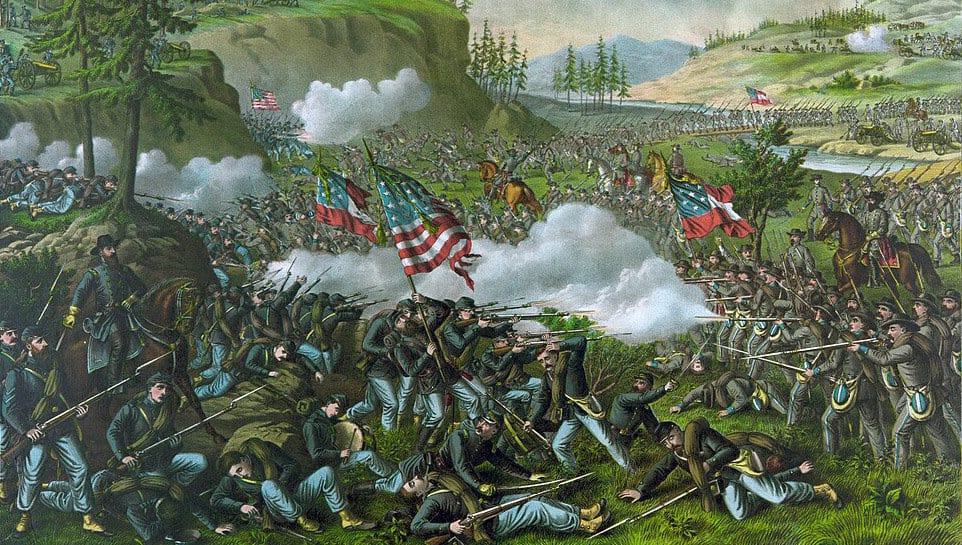September 20, 1863 – October 3, 1863
By Phil Kohn
Phil Kohn can be reached at USCW160@yahoo.com
On September 20, 1863, the second day of the Battle of Chickamauga, there is a major Confederate stroke of luck. The bulk of Lt. Gen. James Longstreet’s divisions arrives in the center of the battlefield just after a Federal division has been moved from the middle of the line to the Union left. Longstreet’s men pour into the gap, split the Union line and crush Rosecrans’s force. A general rout ensues, and Federal troops retreat all the way back to Chattanooga, some nine miles to the north. Only a valiant and stubborn stand by the Union rearguard, led by Maj. Gen. George Thomas (who gains the nickname “Rock of Chickamauga”), prevents a total disaster for the Northerners. Casualty figures for the two days are horrific: 16,169 of 58,000 Federals engaged, and 18,274 of 68,000 Confederates. By the end of the action, Rosecrans and his force are bottled up in Chattanooga, with Confederates commanding all approaches from the west, south and east.
On the morning of September 21, Lt. Gen. Longstreet urges Gen. Bragg to move quickly against the demoralized enemy, but Bragg is slow and doesn’t issue the order to do so until 4:00 p.m. — too late to reach Chattanooga and giving the Federals time to organize their defenses. In Knoxville, Tennessee, Maj. Gen. Ambrose Burnside receives a telegram from President Lincoln: “Go to Rosecrans with your forces, without a moments [sic] delay.” Burnside, with Confederate troops in western Virginia to his northeast, instead decides to ignore the directive and remain at Knoxville.
Gen. Bragg on September 22 orders an attack on Federal positions below Missionary Ridge in Chattanooga, Tennessee. Finding the Union solders well dug-in, Bragg cancels the attack. Bragg’s Confederates move to commanding positions on Missionary Ridge and Lookout Mountain, overlooking the defeated Army of the Cumberland that is bottled up and now besieged in Chattanooga below.
On September 23, Maj. Gen. U.S. Grant receives orders from Washington to transfer troops from Vicksburg, Mississippi, to Rosecrans at Chattanooga. Similarly, it is decided to move two corps from the Army of the Potomac to support Rosecrans.
On September 24, the Federal XI Corps and XII Corps are sent by train from Maj. Gen. Meade’s Army of the Potomac, at Culpeper Court House, Virginia, to shore up Rosecrans’s force at Chattanooga. Commanding the two corps is Maj. Gen. Joseph Hooker.
Maj. Gen. Ambrose Burnside moves part of his force out of Knoxville and engages in extensive fighting against Confederates at Blountville, Tennessee, on September 25. Both sides claim victory, but upon hearing of the action at Chickamauga Creek, in Georgia, Burnside withdraws and begins moving his force back to Knoxville.
From Richmond, Virginia, President Jefferson Davis on September 28 alerts Gen. Bragg at Chattanooga that Federal reinforcements are on their way. In Chattanooga, Maj. Gen. Rosecrans, facing criticism of his handling of the battle — that he advanced recklessly and then lost his nerve when Longstreet attacked — places the blame for the defeat on two of his subordinates: Maj. Gens. Alexander McCook and Thomas Crittenden. The two men are subsequently exonerated.
Gen. Braxton Bragg, fed up with the insolent and contemptuous behavior of his subordinates, strikes a blow. On September 29, he relieves from command Lt. Gen. Leonidas Polk, with whom he has had run-ins over the past year. (Polk is one of the officers who had earlier urged President Davis to remove Bragg from command.) Bragg orders Polk court-martialed for failing to carry out attack orders and for being late to attack on the second day of the battle. (President Davis, a good friend of Polk’s since their days together as cadets at West Point, countermands Bragg’s court-martial order, however, and has Polk — despite his insubordinations and a remarkable lack of success — re-assigned to command the Department of Mississippi and East Louisiana.)
Seeing that the Federals have no intention of leaving Chattanooga, Gen. Bragg on September 30 orders Maj. Gen. Joseph Wheeler to conduct cavalry raids against the Union lines of communication.
On October 1, Confederate Maj. Gen. Joseph Wheeler leads 4,000 cavalrymen accompanied by eight guns on a nine-day raid through Tennessee northwest of Chattanooga. This activity slows Union Maj. Gen. Joseph Hooker, who is attempting to bring two corps (20,000 men and 3,000 horses and mules) from the Army of the Potomac to Chattanooga via the railroad that runs through the area.
The next day, October 2, Hooker and his men begin arriving at Bridgeport, northern Alabama, in support of the 45,000 Union troops besieged in Chattanooga. Hooker’s force has traveled 1,159 miles in nine days by trains from Virginia, traveling through West Virginia, Ohio, Indiana, Kentucky and Tennessee to get there. However, pressure on the Union Army increases as food supplies dwindle. Confederates control the Tennessee River into the city, and all roads on the south side of the city, including the important road to Bridgeport, Alabama. The only road open to the Federals is a rugged, muddy trail through the mountains, and that route is susceptible to raiding by Wheeler’s cavalry.
In Louisiana, U.S. Maj. Gen. Nathaniel Banks on October 3 dispatches Maj. Gen. William Franklin and 20,000 troops from New Iberia, Louisiana, northwestward along Bayou Teche. Banks himself prepares to head for the coast of Texas, hoping once again to gain a foothold there after the previous failure at Sabine Pass. In Tennessee, Maj. Gen. Joe Wheeler’s Confederate cavalry continues to attack troops and supply routes around Chattanooga.








